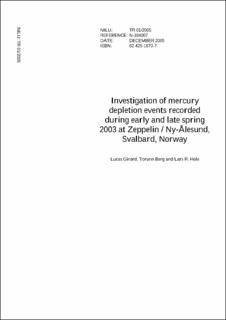Investigation of mercury depletion events recorded during early and late spring 2003 at Zeppelin/Ny-Ålesund, Svalbard (Norway).
| dc.contributor.author | Girard, Lucas | |
| dc.contributor.author | Berg, Torunn | |
| dc.contributor.author | Hole, Lars Robert | |
| dc.date.accessioned | 2021-06-29T10:31:17Z | |
| dc.date.available | 2021-06-29T10:31:17Z | |
| dc.date.issued | 2005 | |
| dc.identifier.issn | 0807-7185 | |
| dc.identifier.uri | https://hdl.handle.net/11250/2761915 | |
| dc.description.abstract | Since February 2000, gaseous elemental mercury (GEM) is continuously monitored at the Zeppelin station, close to Ny-Ålesund. The concentration of GEM remains quite constant throughout the year, around the background value, except for a three month period following the polar sunrise during which it encounters several rapid depletions, dropping down to very low levels, below the detection limit. These events are referred to as atmospheric mercury depletion events (AMDEs) and they are the result of the oxidation of GEM by bromine (BrO) free radicals. While most studies on AMDEs focus on the period with the most serious events (April in Ny-Ålesund), early and late spring 2003 (17/03 to 14/04 and 04/05 to 30/05) were examined in this study. | |
| dc.language.iso | eng | |
| dc.publisher | NILU | |
| dc.relation.ispartof | NILU TR | |
| dc.relation.ispartofseries | NILU TR;01/2005 | |
| dc.subject | Zeppelinobservatoriet | |
| dc.subject | Kvikksølv | |
| dc.subject | Polare områder | |
| dc.subject | Atmosfære og klima | |
| dc.title | Investigation of mercury depletion events recorded during early and late spring 2003 at Zeppelin/Ny-Ålesund, Svalbard (Norway). | |
| dc.type | Research report | |
| dc.rights.holder | © NILU | |
| dc.source.issue | 01/2005 |
Tilhørende fil(er)
Denne innførselen finnes i følgende samling(er)
-
Tekniske rapporter (1970-2014) [389]
Rapporter i de avsluttede seriene Teknisk notat og Teknisk rapport (NILU TN og NILU TR).
